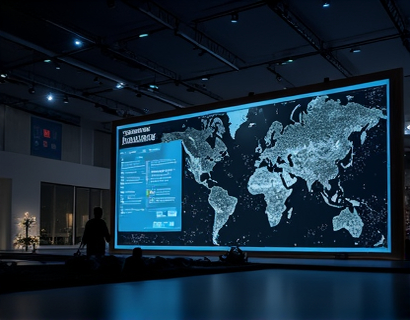Maximizing Business Efficiency: Leveraging Next-Gen Distributed Networks for Global Connectivity and Operational Excellence
In today's rapidly evolving business landscape, the ability to connect globally and operate with seamless efficiency is no longer a luxury but a necessity. The advent of next-generation distributed networks offers a transformative solution, enabling organizations to achieve unparalleled connectivity and operational excellence. This article delves into the intricacies of these advanced network solutions, exploring how they can revolutionize global business operations and enhance communication.
The foundation of modern business efficiency lies in robust and reliable networking infrastructure. Traditional centralized networks often struggle to meet the demands of global operations, leading to latency, data bottlenecks, and increased risk of downtime. Next-generation distributed networks address these challenges by distributing network functions across multiple nodes, creating a more resilient and efficient system.
Understanding Distributed Networks
Distributed networks are architectures where resources and functions are spread across multiple interconnected nodes. Unlike traditional centralized networks, which rely on a single point of control, distributed networks leverage the collective power of multiple nodes to perform tasks. This decentralization offers several key advantages:
- Enhanced reliability: With multiple nodes, the network can continue to function even if one or more nodes fail.
- Improved scalability: Additional nodes can be easily added to handle increased load without significant performance degradation.
- Reduced latency: Data can be processed closer to its source, minimizing the time it takes for information to travel across the network.
- Increased security: Distributed networks can implement more sophisticated security measures, as there is no single point of failure for attackers to exploit.
These benefits make distributed networks an attractive option for businesses operating on a global scale. By leveraging a distributed architecture, companies can ensure that their operations remain smooth and efficient, even in the face of potential network disruptions.
Global Connectivity Through Distributed Networks
Global connectivity is crucial for businesses that operate across multiple time zones and geographic regions. Distributed networks excel in this area by providing a seamless and high-speed connection infrastructure. Here’s how:
Firstly, distributed networks utilize a mesh-like topology where each node is connected to multiple other nodes. This creates multiple pathways for data to travel, reducing the likelihood of bottlenecks and ensuring that data can be transmitted quickly and reliably, regardless of the distance.
Secondly, these networks often employ advanced routing algorithms that dynamically adjust to network conditions. This means that data can be rerouted in real-time to avoid congested paths, further enhancing the speed and reliability of global communications.
For instance, a multinational corporation with offices in North America, Europe, and Asia can benefit immensely from a distributed network. Data transmitted between these regions will experience minimal latency, allowing for real-time collaboration and decision-making. This level of connectivity is essential for maintaining operational efficiency and staying competitive in the global market.
Operational Excellence Through Automation and Orchestration
Beyond enhancing connectivity, distributed networks play a pivotal role in achieving operational excellence through automation and orchestration. Automation involves the use of software and hardware to perform tasks without human intervention, while orchestration coordinates these automated processes to work together seamlessly.
In a distributed network, automation can be applied to various aspects of network management, such as traffic routing, security monitoring, and resource allocation. For example, automated systems can detect and mitigate security threats in real-time, ensuring that the network remains secure and operational.
Orchestration takes automation a step further by coordinating multiple automated processes. This ensures that network resources are used efficiently and that tasks are executed in the most optimal sequence. For instance, during peak usage times, the network can automatically allocate more resources to critical applications, ensuring that performance remains high.
These capabilities are particularly valuable for businesses with complex global operations. By automating routine tasks and orchestrating network functions, companies can reduce the burden on IT staff, minimize human errors, and focus on core business activities. This leads to increased productivity and a more agile response to market changes.
Case Studies: Real-World Applications
To better understand the practical benefits of distributed networks, let’s examine a few real-world applications:
One notable example is a global e-commerce platform that experiences high traffic during sales events. By implementing a distributed network, the platform can distribute the load across multiple data centers located in different regions. This not only reduces latency for users but also ensures that the platform remains responsive and available, even during peak traffic periods.
Another example is a financial services company that operates in multiple countries. This company uses a distributed network to ensure that transaction data is processed and verified in real-time, regardless of the user’s location. The distributed architecture provides the necessary speed and reliability, reducing the risk of transaction delays and enhancing customer trust.
These case studies demonstrate how distributed networks can be tailored to meet the specific needs of various industries, driving operational excellence and customer satisfaction.
Challenges and Considerations
While the benefits of distributed networks are clear, there are several challenges and considerations that organizations should be aware of:
First, the initial setup and migration to a distributed network can be complex and resource-intensive. It requires a thorough assessment of existing infrastructure and a strategic plan for implementation.
Second, managing a distributed network involves monitoring and maintaining multiple nodes, which can increase the complexity of network management. However, advanced management tools and automation can mitigate this challenge by providing centralized oversight and control.
Third, security remains a critical concern. While distributed networks can enhance security through redundancy and decentralization, they also introduce new potential attack vectors. Organizations must implement robust security measures, such as encryption, access controls, and continuous monitoring, to protect their networks.
By carefully addressing these challenges, businesses can fully leverage the advantages of distributed networks and achieve their operational goals.
Future Trends in Distributed Networking
The field of distributed networking is rapidly evolving, with several emerging trends poised to further enhance global connectivity and operational efficiency:
First, the integration of artificial intelligence (AI) and machine learning (ML) into distributed networks is becoming increasingly prevalent. AI-driven analytics can provide deep insights into network performance, enabling proactive maintenance and optimization.
Second, the rise of edge computing complements distributed networking by processing data closer to the source, reducing latency and bandwidth usage. This synergy between edge computing and distributed networks will continue to drive innovation in real-time data processing and analytics.
Third, the adoption of 5G and beyond technologies will significantly boost the capabilities of distributed networks, offering even higher speeds and lower latency. This will open up new possibilities for applications such as IoT, augmented reality, and autonomous systems.
Staying ahead of these trends will be crucial for businesses looking to maintain a competitive edge in the global market.
Conclusion
In conclusion, next-generation distributed networks represent a transformative force in the world of business networking. By providing enhanced global connectivity, operational excellence, and robust security, these networks empower organizations to achieve their full potential. As technology continues to advance, the benefits of distributed networking will only grow, making it an essential component of any forward-thinking business strategy.










































